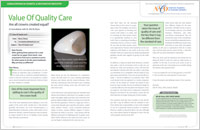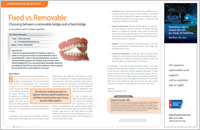Bridges & Crowns Guelph

Dentistry is a science as well as art. Placement of dental crown offers a perfect example of this. A “cap” or dental crown is a covering that is fitted over a decayed, damage or unattractive teeth. They can even replace teeth entirely as placement of dental bridgework.
A crown is placed so that it completely covers a tooth right above the gum line. In contrast to dental veneers, which only over a tooth from the front surface and then needs natural tooth structure for support. When a tooth is missing a significant amount of structure above the gum line, a good restoration choice would be using a crown.
Damaged teeth can be strengthened by crowns, allowing normal function to happen again. Upon creation using today’s high-tech porcelains (dental ceramics), crowns are basically invisible from natural teeth. It can even be designed to help improve the original appearance of your teeth.
There are materials other than porcelain that can be used to make dental crowns, depending on what qualities are needed. For the best durability, cast gold is the best way to go. Although, this is not always the best anesthetic choice —especially when working in the front of the mouth. Other possibilities may include porcelain-fused-to-metal-crowns (PFM), which consist of interior metal for strength and a porcelain exterior for a natural appearance, and/or all-porcelain crowns with zirconia, composed of the strongest ceramic dental material that can be used. We are always willing to discuss with you the pros and cons of these various options.
Crowning or Capping a Tooth

Capping or crowning a tooth will usually consist of two to three visits. Upon the first visit, your tooth will be prepared to receive the new crown. First, by shaping your tooth to fit inside the new cap or crown. This may involve some drilling to give your tooth an even shape. The tooth along with the surrounding area will be prepared with a numbing injection. If the tooth has very little structure left, the tooth may have to be lifted up by filling it with additional material, rather than just filed down, to support the crown.
After tooth preparation is completed, an impression of your tooth is taken, either with reliable putty-like impression materials or digitally and then are sent off to the dental laboratory. While there, the impressions will be used to create the model of your tooth for creating the crown. The model serves as a guide to the skilled technicians in the lab, who are there to ensure that your newly created crown is designed to enhance the function of your bite and your smile.
Creating a Bridge

Dental Crowns can also be used to create the most realistic replacement for a missing tooth. This is done in conjunction with dental bridge work, which uses the space of missing teeth and requires at minimum three crowns. Two of the crowns are placed over healthy teeth on each side of the missing tooth, and the healthy teeth are abutment teeth. The two crowned abutment teeth are used as the support system for a third crown placed in the middle of them; the third crown is the Pontic. If more than one tooth is missing, additional crowns will be used.
The amount of abutment teeth used to replace missing teeth is dependent upon the number of missing teeth, size and length of the abutment tooth roots, the bone support available for each, and also the location in the mouth of the missing tooth. For example, if you have three missing teeth, four abutment teeth may be necessary, thereby creating a seven tooth bridge. Designing and engineering of the dental bridge requires an understanding of how to replace teeth, as well as the biology of supporting gum and bone tissue.
Caring for Your Crowns & Bridgework
Crowns and Bridgework require the same type of maintenance and care as your natural teeth. You want to make sure to brush and floss between all of your teeth, no matter if restored or natural, even day to help reduce the buildup of dental plaque. If you have dental crowns, even more important is regularly scheduled dental maintenance of your teeth. Avoid using your teeth as tools) to open packages, for example). If you grind your teeth, use of a mouth night-guard would be helpful to protect your teeth and your investment.
Related Articles
 Porcelain Crowns & Veneers Dear Doctor
Porcelain Crowns & Veneers Dear Doctor magazine examines two innovative strategies for improving your smile. In many instances, these two restorative techniques can produce nearly identical aesthetic results, even though they are designed differently for handling different structural problems...
Read Article
 Value Of Quality Care
Value Of Quality Care Are all crowns created equal? And why are some crowns more expensive than others? Crown fabrication costs depend upon the materials used and the time needed to create them, among other factors.
Dear Doctor magazine examines these variables...
Read Article
 Fixed vs. Removable Bridgework
Fixed vs. Removable Bridgework For those patients who have lost all their teeth, but have not lost significant bone, a fixed bridge (permanent non-removable teeth) may be the treatment of choice. For those who have severe bone loss, an implant-supported overdenture offers significant advantages...
Read Article
 Dentistry is a science as well as art. Placement of dental crown offers a perfect example of this. A “cap” or dental crown is a covering that is fitted over a decayed, damage or unattractive teeth. They can even replace teeth entirely as placement of dental bridgework.
A crown is placed so that it completely covers a tooth right above the gum line. In contrast to dental veneers, which only over a tooth from the front surface and then needs natural tooth structure for support. When a tooth is missing a significant amount of structure above the gum line, a good restoration choice would be using a crown.
Damaged teeth can be strengthened by crowns, allowing normal function to happen again. Upon creation using today’s high-tech porcelains (dental ceramics), crowns are basically invisible from natural teeth. It can even be designed to help improve the original appearance of your teeth.
There are materials other than porcelain that can be used to make dental crowns, depending on what qualities are needed. For the best durability, cast gold is the best way to go. Although, this is not always the best anesthetic choice —especially when working in the front of the mouth. Other possibilities may include porcelain-fused-to-metal-crowns (PFM), which consist of interior metal for strength and a porcelain exterior for a natural appearance, and/or all-porcelain crowns with zirconia, composed of the strongest ceramic dental material that can be used. We are always willing to discuss with you the pros and cons of these various options.
Dentistry is a science as well as art. Placement of dental crown offers a perfect example of this. A “cap” or dental crown is a covering that is fitted over a decayed, damage or unattractive teeth. They can even replace teeth entirely as placement of dental bridgework.
A crown is placed so that it completely covers a tooth right above the gum line. In contrast to dental veneers, which only over a tooth from the front surface and then needs natural tooth structure for support. When a tooth is missing a significant amount of structure above the gum line, a good restoration choice would be using a crown.
Damaged teeth can be strengthened by crowns, allowing normal function to happen again. Upon creation using today’s high-tech porcelains (dental ceramics), crowns are basically invisible from natural teeth. It can even be designed to help improve the original appearance of your teeth.
There are materials other than porcelain that can be used to make dental crowns, depending on what qualities are needed. For the best durability, cast gold is the best way to go. Although, this is not always the best anesthetic choice —especially when working in the front of the mouth. Other possibilities may include porcelain-fused-to-metal-crowns (PFM), which consist of interior metal for strength and a porcelain exterior for a natural appearance, and/or all-porcelain crowns with zirconia, composed of the strongest ceramic dental material that can be used. We are always willing to discuss with you the pros and cons of these various options.
 Capping or crowning a tooth will usually consist of two to three visits. Upon the first visit, your tooth will be prepared to receive the new crown. First, by shaping your tooth to fit inside the new cap or crown. This may involve some drilling to give your tooth an even shape. The tooth along with the surrounding area will be prepared with a numbing injection. If the tooth has very little structure left, the tooth may have to be lifted up by filling it with additional material, rather than just filed down, to support the crown.
After tooth preparation is completed, an impression of your tooth is taken, either with reliable putty-like impression materials or digitally and then are sent off to the dental laboratory. While there, the impressions will be used to create the model of your tooth for creating the crown. The model serves as a guide to the skilled technicians in the lab, who are there to ensure that your newly created crown is designed to enhance the function of your bite and your smile.
Capping or crowning a tooth will usually consist of two to three visits. Upon the first visit, your tooth will be prepared to receive the new crown. First, by shaping your tooth to fit inside the new cap or crown. This may involve some drilling to give your tooth an even shape. The tooth along with the surrounding area will be prepared with a numbing injection. If the tooth has very little structure left, the tooth may have to be lifted up by filling it with additional material, rather than just filed down, to support the crown.
After tooth preparation is completed, an impression of your tooth is taken, either with reliable putty-like impression materials or digitally and then are sent off to the dental laboratory. While there, the impressions will be used to create the model of your tooth for creating the crown. The model serves as a guide to the skilled technicians in the lab, who are there to ensure that your newly created crown is designed to enhance the function of your bite and your smile.
 Dental Crowns can also be used to create the most realistic replacement for a missing tooth. This is done in conjunction with dental bridge work, which uses the space of missing teeth and requires at minimum three crowns. Two of the crowns are placed over healthy teeth on each side of the missing tooth, and the healthy teeth are abutment teeth. The two crowned abutment teeth are used as the support system for a third crown placed in the middle of them; the third crown is the Pontic. If more than one tooth is missing, additional crowns will be used.
The amount of abutment teeth used to replace missing teeth is dependent upon the number of missing teeth, size and length of the abutment tooth roots, the bone support available for each, and also the location in the mouth of the missing tooth. For example, if you have three missing teeth, four abutment teeth may be necessary, thereby creating a seven tooth bridge. Designing and engineering of the dental bridge requires an understanding of how to replace teeth, as well as the biology of supporting gum and bone tissue.
Dental Crowns can also be used to create the most realistic replacement for a missing tooth. This is done in conjunction with dental bridge work, which uses the space of missing teeth and requires at minimum three crowns. Two of the crowns are placed over healthy teeth on each side of the missing tooth, and the healthy teeth are abutment teeth. The two crowned abutment teeth are used as the support system for a third crown placed in the middle of them; the third crown is the Pontic. If more than one tooth is missing, additional crowns will be used.
The amount of abutment teeth used to replace missing teeth is dependent upon the number of missing teeth, size and length of the abutment tooth roots, the bone support available for each, and also the location in the mouth of the missing tooth. For example, if you have three missing teeth, four abutment teeth may be necessary, thereby creating a seven tooth bridge. Designing and engineering of the dental bridge requires an understanding of how to replace teeth, as well as the biology of supporting gum and bone tissue.
 Porcelain Crowns & Veneers Dear Doctor magazine examines two innovative strategies for improving your smile. In many instances, these two restorative techniques can produce nearly identical aesthetic results, even though they are designed differently for handling different structural problems... Read Article
Porcelain Crowns & Veneers Dear Doctor magazine examines two innovative strategies for improving your smile. In many instances, these two restorative techniques can produce nearly identical aesthetic results, even though they are designed differently for handling different structural problems... Read Article
 Value Of Quality Care Are all crowns created equal? And why are some crowns more expensive than others? Crown fabrication costs depend upon the materials used and the time needed to create them, among other factors. Dear Doctor magazine examines these variables... Read Article
Value Of Quality Care Are all crowns created equal? And why are some crowns more expensive than others? Crown fabrication costs depend upon the materials used and the time needed to create them, among other factors. Dear Doctor magazine examines these variables... Read Article
 Fixed vs. Removable Bridgework For those patients who have lost all their teeth, but have not lost significant bone, a fixed bridge (permanent non-removable teeth) may be the treatment of choice. For those who have severe bone loss, an implant-supported overdenture offers significant advantages... Read Article
Fixed vs. Removable Bridgework For those patients who have lost all their teeth, but have not lost significant bone, a fixed bridge (permanent non-removable teeth) may be the treatment of choice. For those who have severe bone loss, an implant-supported overdenture offers significant advantages... Read Article
